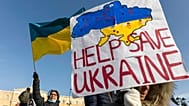It is estimated that wildfires have ravaged more than 46,000 hectares this year in the UK, the largest area since monitoring began.
The UK has been warned it is “dangerously unprepared” for the growing threat of wildfires, flooding and the wider impacts of the climate crisis - as experts call for “immediate” investment.
From January to November, the Global Wildfire Information System estimates that wildfires have burned a staggering 47,026 hectares in the UK.
This marks the largest area in any year since monitoring began in 2012 and is double the area burned in the record-breaking summer of 2022, where the Met Office found climate change made severe fires six times more likely.
‘Limiting the damage’ of climate change
The record number of blazes has resulted in calls for the UK governmentto “limit the damage of climate change” by urgently slashing carbon emissions.
The Fire Brigades Union, which represents firefighters and control staff in the UK, warns the number of days with “very high” fire danger will triple by the 2050s and rise more than fivefold by the 2080s if global warming continues to accelerate.
The risk of intense rainfall is also rising sharply, posing a serious flood risk across the country “now and in the future”. Just this weekend, Storm Claudia brought severe flooding to parts of Wales and England, with at least one major incident declared.
The union has therefore written a letter to the Chancellor of the Exchequer, Rachel Reeves and the Secretary of State for Energy and Climate Change Ed Miliband, urging the UK to implement a nationwide strategy to prepare fire and rescue services for the “accelerating climate crisis”.
The UK’s budget cuts
“The fire and rescue service has lost nearly 12,000 firefighters since 2010, equating to one in five posts,” the letter – which has also been signed by Greenpeace, Tax Justice UK, and Friends of the Earth – reads.
“Central government funding has been cut by 30 per cent in cash terms alone, and a lot more in real terms.”
The union argues this has resulted in many services facing equipment shortages, under-staffed control rooms and “insufficient” protective gear.
Back in August, 17 fire and rescue services were drafted in from as far as Greater Manchester to respond to a wildfirein Holt Heath, Dorset (around 363km away).
Many firefighters responding to the incident didn’t have specialist wildfire PPE, putting them at increased risk of heat stroke, exhaustion and burns.
Despite the clear struggles of investment cuts, the union argues this year’s Local Government Settlement is eying up more reductions.
“Modelling by the National Fire Chiefs Council (NFCC) has shown that another £102 million [approximately €116 million] could be cut to make up for the shortfall in budgets, leaving fire services less capable of responding to major incidents,” the letter adds.
Wildfires in Europe
Over in mainland Europe, the picture is equally bleak, with more than a million hectaresgoing up in flames in the EU so far this year.
This is four times as much land as last year, and equates to a surface area larger than the entirety of Corsica.
In total, more than 1,800 forest fires have been declared, emitting more than 38 million tonnes of CO₂. Out of the EU’s 27 member states, only the Czech Republic, Estonia, Lithuania, Luxembourg and Malta have reported no wildfires in 2025.
Is climate change to blame?
"Many of the fires we have monitored and observed are occurring where climate anomalies show that it is much drier than average and warmer than average," Mark Parrington, a scientist at the European Centre for Medium-Range Weather, told Euronews.
The expert warns that when hot, dry winds are blowing - ignition can spark “very quickly” on a large scale and become “very intense”.
Portugal and Spain both witnessed record-breaking wildfires this summer, which accounted for over two-thirds of EU devastation, fuelled by temperatures above 40°C and strong winds.
These deadly blazes were around 40 times more likely due toclimate change, research by the World Weather Attribution (WWA) found.
“With every fraction of a degree of warming, extreme, long-lasting heatwaves will continue to intensify, increasing the chance of huge wildfires like the ones that burned vast areas of the Iberian Peninsula,” warns Dr Clair Barnes, researcher for the Centre for Environmental Policy at Imperial College London.
Is the EU spending enough money to tackle wildfires?
Between 2022 and 2023, EU governments increased spending on fire-protection services by 8.5 per cent, reaching €40.6 billion.
However, unions across Europe say that is far from enough given the growing threats linked to climate change.
“As fires and flooding increase due to climate change, we cannot have standstill budgets,” said EPSU’s secretary general, Jan Willem Goudriaa.
“It is now time to substantially increase public investment for forest maintenance, water management, fire services, and civil protection, as well as prevention.”
Germany, France, Poland, Italy, and Spain employ the largest forces of professional firefighters, each with between 42,100 and 61,700 firefighters.
However, in 2024, Portugal had decreased their recruitment by six per cent.
Euronews Green has contacted the UK's Department for Energy Security and Net Zero for comment.


















